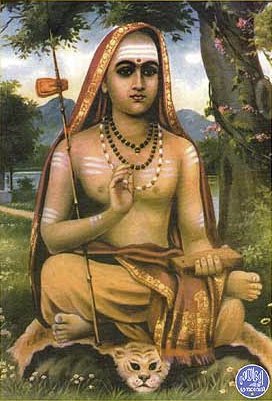Prashna Upanishad with Shankara’s Commentary
by S. Sitarama Sastri | 1928 | 19,194 words
The Prashna Upanishad is a series philosophical poems presented as questions (prashna) inquired by various Hindu sages (Rishi) and answered by Sage Pippalada. The questions discuss knowledge about Brahman, the relation of the individual (Purusha) with the universal (Atman), meditation, immortality and various other Spiritual topics. This commentar...
Verse 4.8
पृथिवी च पृथिवीमात्रा चापश्चापोमात्रा च तेजश्च तेजोमात्रा च वायुश्च वायुमात्रा चाकाशश्चाकाशमात्रा च चक्शुश्च द्रष्टव्यं च श्रोत्रं च श्रोतव्यं च घ्राणं च घ्रातव्यं च रसश्च रसयितव्यं च त्वक्च स्पर्शयितव्यं च वाक्च वक्तव्यं च हस्तौ चादातव्यं चोपस्थश्चानन्दयितव्यं च पायुश्च विसर्जयितव्यं च यादौ च गन्तव्यं च मनश्च मन्तव्यं च बुद्धिश्च बोद्धिव्यं चाहङ्कारश्चाहङ्कर्तव्यं च चित्तं च चेतयितव्यं च तेजश्च विद्योतयितव्यं च प्राणश्च विद्यारयितव्यं च ॥ ८ ॥
pṛthivī ca pṛthivīmātrā cāpaścāpomātrā ca tejaśca tejomātrā ca vāyuśca vāyumātrā cākāśaścākāśamātrā ca cakśuśca draṣṭavyaṃ ca śrotraṃ ca śrotavyaṃ ca ghrāṇaṃ ca ghrātavyaṃ ca rasaśca rasayitavyaṃ ca tvakca sparśayitavyaṃ ca vākca vaktavyaṃ ca hastau cādātavyaṃ copasthaścānandayitavyaṃ ca pāyuśca visarjayitavyaṃ ca yādau ca gantavyaṃ ca manaśca mantavyaṃ ca buddhiśca boddhivyaṃ cāhaṅkāraścāhaṅkartavyaṃ ca cittaṃ ca cetayitavyaṃ ca tejaśca vidyotayitavyaṃ ca prāṇaśca vidyārayitavyaṃ ca || 8 ||
8. Earth and its subtle form, water and its subtle form, fire and its subtle form, air and its subtle form, akasa and its subtle form, sight and its objects, taste and its objects, touch and its objects, speech and object, hands and what is to be handled, the organ of generation and what is to be enjoyed, the organ of excretion and what must be excreted, the feet and what is to be trodden on by them, mind and what must be thought, the intellect and what must be determined, egotism and its object, Chitta and its object, light and its object, and Prana and what must be supported by it.
Shankara’s Commentary:
Com.—What is that all? The earth gross, having five attributes and its cause, the rudiment of earth, i.e., the subtle form of smell, so water and the subtle form of water, fire and its subtle form, air and its subtle form, akasa and its subtle form, i.e., all gross and subtle Bhutas; similarly, the sense of sight and its objects, ear and its objects, nose and its objects, the palate and its objects, touch and its objects, speech and what must be said, hands and what must be handled, the organ of generation and what must be enjoyed, the organ of excretion and what must be excreted, feet and what must be reached; thus, all the intellectual and active senses have been mentioned. The mind already stated and its objects, the intellect consisting in determination and its objects, ahankara, i.e., the mind characterised by egotism and its objects, Chittam, i.e., the intelligent mind and its objects. Tejas ] The skin apart from the sense of touch, having light. Vidyotayitavyam ] the objects enlightened by it. Prana, what is called the sutra, and what is strung on it, i.e., all the bundle of effects and instruments combined for the benefit of some other entity, having name, form, etc.
